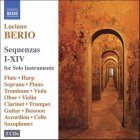 Sequenzas I-XIV
Sequenzas I-XIVLuciano Berio (1925 – 2003)
Naxos Classical, Naxos 557661-3
2006
Luciano Berio was an avant-garde Italian composer who loomed very large over the “classical” music landscape of the second half of the Twentieth Century. A native of Oneglia (now Borgo d'Oneglia), Berio was originally educated by his father and grandfather both of who were organists. His formal training was achieved at the Milan Conservatory under Giulio Cesare Paribeni and Giorgio Federico Ghedini where he studied piano. Berio was forced to abandon his piano studies due to a hand injury he sustained in World War II, and he instead concentrated his efforts toward composition.
In the early 1950s, Berio came to the United States and studied at Tanglewood. He later studied at the Internationale Ferienkurse für Neue Musik at Darmstadt, where he cam into contact with such musical luminaries as Mauricio Kagel, Karlheinz Stockhausen, Pierre Boulez, and György Ligeti. He spent the rest of his life teaching and composing in the United States and abroad.
Among the many types of compositions in which Berio excelled, his solo outings, entitle Sequenzas are perhaps his most famous. He began the composition of the Sequenzas in 1958 with Sequenza I for flute and ended with Sequenza XIV for violoncello in 2002, completed a year prior to the composer’s death at 77. Before the release of Naxos Classical’s Sequenzas I-XVI for Solo Instuments the most complete collection was the splendid 20/21 - Berio: Sequenzas / Ensemble InterContemporain (Deutsche Grammophon, 1057788, 1999).
Naxos Classical forges ahead in its attempt to document any and all art music with the release of Sequenzas I-XVI for Solo Instruments. This is the first complete set of the Sequenzas since Berio’s death and it is very fine. But in all of its fineness, the Sequenzas are a bit hard to describe in the same way that Ornette Coleman’s Free Jazz or John Coltrane’s Interstellar Space are hard to describe. The Sequenzas are among the most “free” compositions of any genera captured on record.
A single listen to these pieces is not adequate. Each instrument brings its own personality and Berio treats them as such. Berio approached his subjects from many angles. For example, perhaps the most notable of the pieces is Sequenza III for Soprano Voice. Berio composed the piece in 1965 for his former wife Cathy Berberbian, whose instrument possessed great range and depth. Berio’s composition thoroughly tests the robustness of the soprano voice with acute range and octave shifts, fractured arpeggios and breathtaking trills. Listening to the soprano piece is a jarring, bracing experience requiring a Coleridgian “suspension of disbelief,” meaning that the listener needs to put aside his or her preconception of what music is thereby broadening the artistic horizon.
On an equally virtuosic but less serious note is the Sequenza V for Solo Trombone, performed capably by Naxos regular Alain Trudel. This is an almost vaudevillian performance, with Trudel using all of the tricks in the book to make the instrument talk. The string Sequenzas (VI for Solo Viola, VIII for Solo Violin, XI for Solo Guitar and XIV for Cello) are edgy affairs with dense trilling and double-stop modulations (VI for Solo Viola), dissonant double-stops (VIII for Solo Violin), percussive Flamenco schizophrenia (XI for Solo Guitar) and anxious melancholy (XIV for Cello).
Sequenza IX for Solo Clarinet is moody, shrill, nervous while Sequenza X for Solo Trumpet is bright and exuberant quite the opposite of the less serious trombone recital. As a finite collection of music, The Sequenzas exist among the most important compositions of the Twentieth Century. Naxos capably captures these pieces with immediacy and intimacy, as much as the music allows. This recording would please all fans of Classical and Jazz Avant-garde.
Track Listing:
CD 1: Sequenza I for Flute solo, Nora Shulman; Sequenza II for Harp solo, Erica Goodman (Harp); Sequenza III for Female Voice solo, Tony Arnold (Soprano); Sequenza IV for Piano solo, Boris Berman (Piano); Sequenza V for Trombone solo Real Audio, Alain Trudel (Trombone); Sequenza VI for Viola solo, Steven Dann (Viola); Sequenza VII for Oboe solo, Matej Sarc (Oboe).
CD 2: Sequenza VIII for Violin solo, Jasper Wood (Violin) Sequenza IXa for Clarinet solo, Joaquin Valdepenas (Clarinet) Sequenza X for Trumpet and "silent" Piano Guy Few (Trumpet); Sequenza XI for Guitar solo Pablo Sainz Villegas (Guitar).
CD 3 Sequenza XII for Bassoon solo, Kenneth Munday (Bassoon) Sequenza XIII for Accordion solo "Chanson," Joseph Petric (Accordion), Sequenza XIV for Cello solo, Darrett Adkins (Cello); Sequenza VIIb for Soprano Saxophone solo, Wallace Halladay (Soprano Saxophone); Sequenza IXb for Alto Saxophone solo, Wallace Halladay (Alto Saxophone).
